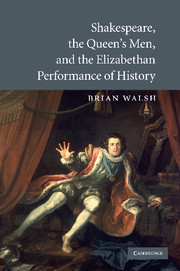Book contents
- Frontmatter
- Contents
- Acknowledgments
- Introduction
- 1 Dialogues with the dead: history, performance, and Elizabethan theater
- 2 Theatrical time and historical time: the temporality of the past in The Famous Victories of Henry V
- 3 Figuring history: Truth, Poetry, and Report in The True Tragedy of Richard III
- 4 “Unkind division”: the double absence of performing history in I Henry VI
- 5 Richard III and Theatrum Historiae
- 6 Henry V and the extra-theatrical historical imagination
- Conclusion: traces of Henry/traces of history
- Bibliography
- Index
Conclusion: traces of Henry/traces of history
Published online by Cambridge University Press: 19 January 2010
- Frontmatter
- Contents
- Acknowledgments
- Introduction
- 1 Dialogues with the dead: history, performance, and Elizabethan theater
- 2 Theatrical time and historical time: the temporality of the past in The Famous Victories of Henry V
- 3 Figuring history: Truth, Poetry, and Report in The True Tragedy of Richard III
- 4 “Unkind division”: the double absence of performing history in I Henry VI
- 5 Richard III and Theatrum Historiae
- 6 Henry V and the extra-theatrical historical imagination
- Conclusion: traces of Henry/traces of history
- Bibliography
- Index
Summary
Henry V was among the first productions put on at the reconstructed Globe Theatre on the Bankside in Southwark in 1997. Like all plays, this Henry V existed in a series of performative presents and then disappeared. Traces still exist, to be sure: playbills, production photographs, newspaper reviews of the show, eyewitness accounts, as well as scholarly articles about it. In addition to all the ways “Shakespeare's Globe,” as it is officially known, strives to recreate Shakespeare's working theater, it also supplies things we wish the Elizabethan version had contained, chiefly, an archive of its own productions where some of these traces have been stored. There is, indeed, one remarkable trace of the 1997 Henry V available at the Globe Library, one more vivid than anything the Lord Chamberlain's or the King's Men could have left behind: videotapes of the performance (the Library houses tapes of every production put on since the Globe opened its doors). Of course, video is far from a cutting-edge technology today. Videotapes have become increasingly irrelevant over the past several years. In addition to being relatively cumbersome and limited in their “storage” capacity, they are warped with frequent use and can be easily snapped by frequent rewinding and fast-forwarding. These records of Globe performances are subject to various kinds of breakdown and erasure, and one wonders when the tapes will all be transferred to fallible but perhaps more durable media such as DVD, Blu-ray disc, or electronic files, and when, or whether, they will all be put in wider circulation, perhaps through sales to individuals or libraries, increasing the chances for preservation.
- Type
- Chapter
- Information
- Publisher: Cambridge University PressPrint publication year: 2009



